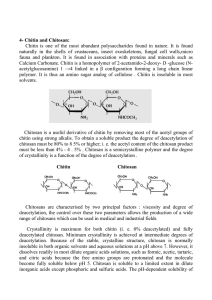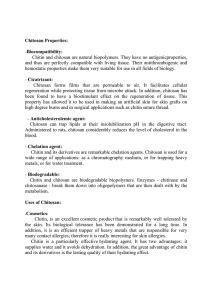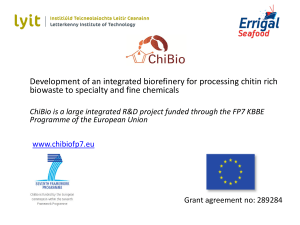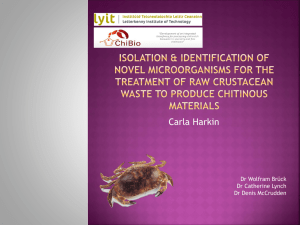International Journal of Fisheries and Aquatic Sciences 3(1): 12-18, 2014
advertisement
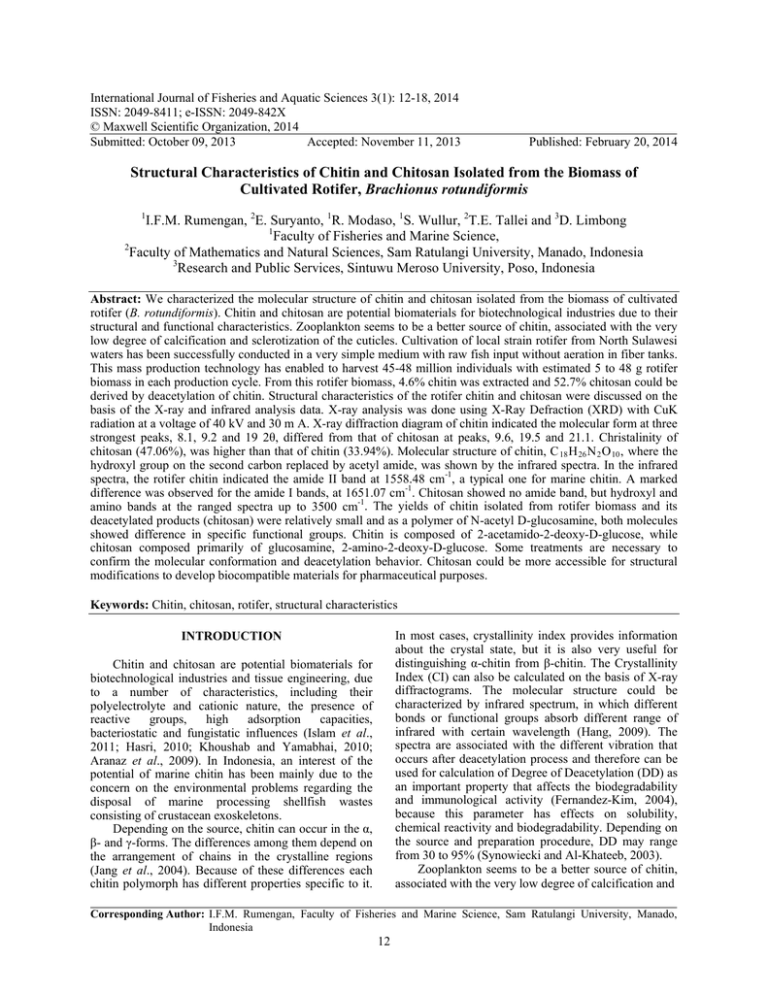
International Journal of Fisheries and Aquatic Sciences 3(1): 12-18, 2014 ISSN: 2049-8411; e-ISSN: 2049-842X © Maxwell Scientific Organization, 2014 Submitted: October 09, 2013 Accepted: November 11, 2013 Published: February 20, 2014 Structural Characteristics of Chitin and Chitosan Isolated from the Biomass of Cultivated Rotifer, Brachionus rotundiformis 1 I.F.M. Rumengan, 2E. Suryanto, 1R. Modaso, 1S. Wullur, 2T.E. Tallei and 3D. Limbong 1 Faculty of Fisheries and Marine Science, 2 Faculty of Mathematics and Natural Sciences, Sam Ratulangi University, Manado, Indonesia 3 Research and Public Services, Sintuwu Meroso University, Poso, Indonesia Abstract: We characterized the molecular structure of chitin and chitosan isolated from the biomass of cultivated rotifer (B. rotundiformis). Chitin and chitosan are potential biomaterials for biotechnological industries due to their structural and functional characteristics. Zooplankton seems to be a better source of chitin, associated with the very low degree of calcification and sclerotization of the cuticles. Cultivation of local strain rotifer from North Sulawesi waters has been successfully conducted in a very simple medium with raw fish input without aeration in fiber tanks. This mass production technology has enabled to harvest 45-48 million individuals with estimated 5 to 48 g rotifer biomass in each production cycle. From this rotifer biomass, 4.6% chitin was extracted and 52.7% chitosan could be derived by deacetylation of chitin. Structural characteristics of the rotifer chitin and chitosan were discussed on the basis of the X-ray and infrared analysis data. X-ray analysis was done using X-Ray Defraction (XRD) with CuK radiation at a voltage of 40 kV and 30 m A. X-ray diffraction diagram of chitin indicated the molecular form at three strongest peaks, 8.1, 9.2 and 19 2θ, differed from that of chitosan at peaks, 9.6, 19.5 and 21.1. Christalinity of chitosan (47.06%), was higher than that of chitin (33.94%). Molecular structure of chitin, C 18 H 26 N 2 O 10 , where the hydroxyl group on the second carbon replaced by acetyl amide, was shown by the infrared spectra. In the infrared spectra, the rotifer chitin indicated the amide II band at 1558.48 cm-1, a typical one for marine chitin. A marked difference was observed for the amide I bands, at 1651.07 cm-1. Chitosan showed no amide band, but hydroxyl and amino bands at the ranged spectra up to 3500 cm-1. The yields of chitin isolated from rotifer biomass and its deacetylated products (chitosan) were relatively small and as a polymer of N-acetyl D-glucosamine, both molecules showed difference in specific functional groups. Chitin is composed of 2-acetamido-2-deoxy-D-glucose, while chitosan composed primarily of glucosamine, 2-amino-2-deoxy-D-glucose. Some treatments are necessary to confirm the molecular conformation and deacetylation behavior. Chitosan could be more accessible for structural modifications to develop biocompatible materials for pharmaceutical purposes. Keywords: Chitin, chitosan, rotifer, structural characteristics In most cases, crystallinity index provides information about the crystal state, but it is also very useful for distinguishing α-chitin from β-chitin. The Crystallinity Index (CI) can also be calculated on the basis of X-ray diffractograms. The molecular structure could be characterized by infrared spectrum, in which different bonds or functional groups absorb different range of infrared with certain wavelength (Hang, 2009). The spectra are associated with the different vibration that occurs after deacetylation process and therefore can be used for calculation of Degree of Deacetylation (DD) as an important property that affects the biodegradability and immunological activity (Fernandez-Kim, 2004), because this parameter has effects on solubility, chemical reactivity and biodegradability. Depending on the source and preparation procedure, DD may range from 30 to 95% (Synowiecki and Al-Khateeb, 2003). Zooplankton seems to be a better source of chitin, associated with the very low degree of calcification and INTRODUCTION Chitin and chitosan are potential biomaterials for biotechnological industries and tissue engineering, due to a number of characteristics, including their polyelectrolyte and cationic nature, the presence of reactive groups, high adsorption capacities, bacteriostatic and fungistatic influences (Islam et al., 2011; Hasri, 2010; Khoushab and Yamabhai, 2010; Aranaz et al., 2009). In Indonesia, an interest of the potential of marine chitin has been mainly due to the concern on the environmental problems regarding the disposal of marine processing shellfish wastes consisting of crustacean exoskeletons. Depending on the source, chitin can occur in the α, β- and γ-forms. The differences among them depend on the arrangement of chains in the crystalline regions (Jang et al., 2004). Because of these differences each chitin polymorph has different properties specific to it. Corresponding Author: I.F.M. Rumengan, Faculty of Fisheries and Marine Science, Sam Ratulangi University, Manado, Indonesia 12 Int. J. Fish. Aquat. Sci., 3(1): 12-18, 2014 sclerotization of the cuticles, with mean chitin production values of 1 g chitin/m2/year (Jeuniaux et al., 1988). As a cosmopolitan zooplankton, rotifer has molecular potential for biotechnological industries (Rumengan, 1997, 2007). Culture of local strain of rotifer (Brachionus rotundiformis) from North Sulawesi waters has been established since 1995 in Laboratory of Marine Biotechnology, Faculty of Fisheries and Marine Science, Sam Ratulangi University (Rumengan et al., 1998, 2007). Recent cultivation of this rotifer in mass culture scale has been developed by using rawfish input, without microalgae and aeration (Dewanto et al., 2012; Limbong et al., 2012) has enabled to harvest 4548 million individuals with estimated 5 to 48 g rotifer biomass in one production cycle. Harvested rotifer has been currently developed as the source of biomass for chitin production. From this rotifer biomass, 4.6% chitin was extracted and 52.7% chitosan could be derived by deacetylation of chitin (Modaso et al., 2013). The purpose of this study was to characterize the molecular structure of chitin dan chitosan isolated from the biomass cultivated rotifer (B. rotundiformis) by using X-ray diffraction for determining the crystallinity of chitins and chitosans and infrated spectra analyses for molecular structure. MATERIALS AND METHODS The rotifer biomass from the culture system (Dewanto et al., 2012) was harvested as described by Rumengan et al. (2012). The method of sample preparation for chitin extraction was previously reported (Modaso et al., 2013). Sample for X-ray diffraction analysis adopted from Khan et al. (2002) was nondestructive (except for grinding). Chitin and chitosan samples were prepared in the form of potassium bromide (KBr) disk and film. The patterns were recorded using X-ray diffractometer with CuK radiation (40 kV, 30 mA) until scanning with XRD spectrum (Carpenter, 2011). Data were collected with the scan angle from 2° to 70°. On the basis of X-ray diffractograms, the Crystallinity Index (CI) was calculated as adopted from Xu et al. (2005) as follows: Crystallinity Index (%) = (Kal Intensity profile/Intensity Smoothing Profile) ×100 Fig. 1: XRD diffractogram of rotifer chitin 13 Int. J. Fish. Aquat. Sci., 3(1): 12-18, 2014 Fig. 2: XRD diffractogram of rotifer chitosan Infrared spectroscopic analysis was adopted from Khan et al. (2002) and Xu et al. (2005). Chitin and chitosan samples were prepared in a potassium bromide (KBr) disk and film. Approximately 40-60 mg of chitosan powder and 120 mg of KBr were blended and triturated with agate mortar and pestle for 10 min. Approximately 40 mg of the mixture were compacted using a IR hydraulic press at a pressure of 8 tons for 60 sec. The disk was conditioned in a desiccator placed in an oven at 80°C for 16 h before analysis. Sample was then inserted into ZnSe ATR cell. crystalline chitin and chitosan have amorphous and crystalline regions (Jung, 2013). The XRD pattern of rotifer chitin exhibited diffraction peaks in the scaterring range (2θ) at 8.1, 9.2 and 19 (Fig. 1) and chitosan at peaks, 9.60, 19.52 and 21.12 (Fig. 2). This is comparable with the pattern of crab chitins, with peaks at 9.1-9.2° and 19.1-19.2° 2θ and the pattern of chitosan with two peaks at 10.1° and 19.8° (Yen and Mau, 2007), similar to the pattern of shrimp chitosan with peaks at 10° and 21° 2θ (Islam et al., 2011), but Prashanth et al. (2002) previously found that the patterns of shrimp chitosan with two major characteristic peaks at 9.9-10.7 and 19.8-20.7° 2θ. The typical chitin and chitosan diffraction pattern, showed strong reflections at 9-10° and 20-21° and minor reflections at 26.4° (Kumirska et al., 2010). XRD pattern is applicable for assessing chitosan as a potent inhibitor of tumor-induced angiogenesis, as developed by Prashant and Tharanathan (2005) who depolimerazed commercial shrimp chitosan, resulted in RESULTS AND DISCUSSION Christalinity of chitin and chitosan was generated from hidrogen bond between corresponding hidroxyl and N-acetyl groups (Bartnicki-Garcia, 1988). Each crystalline peak characterizes crystallographic structure, which is generated from parallel and antiparallel alignments of polymeric chains or sheets. Semi14 Int. J. Fish. Aquat. Sci., 3(1): 12-18, 2014 Table 1: Crystallinity of rotifer chitin and chitosan Intensity smoothing Intensity Crystallinity Product profile kal profile index (%) Chitin 940 319 33.94 Chitosan 1700 800 47.06 appearance of diffractogram peaks at 9.46°, 11.9°, 16.7°, 20.76° and 21, 86°. Two diffraction peaks (9.60° and 21.12°) exhibited by rotifer chitosan with highest peak at 19.1° (Fig. 2) indicating a partial structural modification. As shown in Table 1, the CI for chitin and chitosan of rotifer were 33.94 and 47.06%, respectively. In most cases, crystallinity index provides information about the crystal state, but it is also very useful for distinguishing α-chitin from β-chitin. Many other studies of chitin polymorphs have revealed differences in crystallinity peaks between α-, β- and γ-chitins obtained from various sources (Jang et al., 2004; Cárdenas et al., 2004; Kim et al., 1996). The differences among the α-, β- and γ-forms of chitin are due to the arrangement of the chains in the crystalline regions: α-chitin has a structure of antiparallel chains, β-chitin has intra sheet hydrogen-bonding by parallel chains and γ-chitin, being a combination of α- and β-chitin, has both parallel and antiparallel structures (Jang et al., 2004). Based on vibration modes of different functional groups as characterized by the wave length, the rotifer chitin is comparable to the α-chitin standard as shown in Table 2. The results of FTIR spectra of rotifer chitin and chitosan are shown in Fig. 3 and 4, respectively. The IR Peak 2θ 19°, 9°, 8° 21°, 19°, 9° Table 2: Wave length of the main bands obtained for the αchitin standard (Palpandi et al., 2009) and the rotifer B. rotundiformis chitin Wave length (cm-1) ---------------------------------------α-chitin (cm-1) standard Rotifer chitin Vibration modes OH out-of-plane bending 690 694 NH out-of-plane bending 752 Ring stretching 896 894 CH 3 wagging along chain 952 948 CO stretching 1026 1026 CO stretching 1073 1072 Asymmetric in-phase ring 1116 1157 stretching mode CH 2 bending and CH 3 1418 1427 deformation Amide II band amide II band 1563 1558 Amide I band 1661 1627 CH stretching 2878 Symmetric CH 3 stretching and 2930 2885 asymmetric CH 2 stretching NH stretching 3268 3271 OH stretching 3439 3448 Fig. 3: Infrared spectra as a wave length function displayed by rotifer chitin 15 Int. J. Fish. Aquat. Sci., 3(1): 12-18, 2014 Fig. 4: Infrared spectra as a wave length function displayed by rotifer chitosan Table 3: Functional groups of rotifer chitin compared to commercial standard chitin (Puspawati and Dan Simpen, 2010) Wave length (cm-1) ---------------------------------------------Group Standard chitin Rotifer chitin OH 3448 3448 N-H stretching 3300-3250 3271 C-H stretching 2891, 1 2885 C = O stretching 1680-1660 1627 N-H bending 1560-1530 1558-1562 CH 3 1419, 5 1427 C-O-C 1072, 3 1072 N-H 750-650 694 spectra of the rotifer samples of chtin and chitosan were compared to the IR spectrum of commercial (literature) on Table 3 and 4. The rotifer samples displayed similar IR spectra to that of the commercial chitin and chitosan. The FTIR spectra of rotifer chitin exhibited a characteristic band at 3448 cm-1 is attributed to -NH and -OH groups stretching vibration and the band 2885 cm-1 were an aliphatic C-H stretching bands that converges to OH stretching with N-H. The characteristic carbonyl C = O stretching of chitin at 1627 cm-1 are attributed to the vibrations of the amide I band. The sharp band at 1427 cm-1 corresponds to a symmetrical deformation of the CH 3 group and at 1558 cm-1 corresponds to the N-H deformation of amide II. The vibrations bands at 1072 cm-1 showed C-O-C vibration inside chitin ring and produced many peaks caused by the presence of hydroxide from chitin which contains a single bond C = O (Puspawati and Dan Simpen, 2010). Characteristic of the rotifer chitosan was shown by a broad absorption band in the range 3000 to 3500 cm-1 which is attributed to O-H stretching vibrations and the 3263 cm-1 to vibration of NH. The stretching vibrations Table 4: Functional groups of rotifer chitosan compared to commercial standard chitin (Puspawati and Dan Simpen, 2010) Wave length (cm-1) ----------------------------------------------Standard chitosan Rotifer chitosan Group OH 3450.0 3448 N-H stretchingh 3335.0 3263 C-H stretchingh 2891.1 2854 NH 2 cutting, N-H bending 1655.0 1558 CH 3 1419.5 1419 C-O-C 1072.3 1072 NH 2 850.0-750.0 894 N-H 715.0 694 16 Int. J. Fish. Aquat. Sci., 3(1): 12-18, 2014 of methylene C-H at 2854 cm-1, absorption peak at 1558 cm-1 correspond to the NH 2 . The amide II band is used as the characteristic band of N-acetylation (Islam et al., 2011). The spectra of chitosan showed the different vibration that occurs after deacetylation process, which was not the emergence of vibration C = O at 1627 cm-1 region, which indicates the vibration of C = O has been reduced on chitosan, as well as the emergence of absorption at 894 cm-1 on chitosan rotifer which was the vibration of NH 2 . Chitin C 18 H 26 N 2 O 10 , like cellulose is a β- (1, 4) linked glycan, but is composed of 2-acetamida-2deoxy-D-glucose (N-acetylglucosamine), while chitosan is a low acetyl form of chitin and is composed primarily of glucosamine, 2-amino-2-deoxy-D-glucose (Sanford, 1988). The marked difference between chitin and chitosan IR spectra (Fig. 3 and 4) in the interval 3271-3448 cm-1 could be connected with the larger amount of N-H and O-H groups in chitosan, the larger absorption in chitin at 2885 cm-1 is the consequence of larger amount of C-H bonds. In the infrared spectra, the rotifer chitin indicated the amide II band at 1558.48 cm-1, a typical one for marine chitin. A typical amide I band was found at 1651.07 cm-1. Chitosan showed no amide band, but hydroxyl and, amino bands at the ranged spectra up to 3500 cm-1. In terms of chemical properties, chitosan is more applicable, due to its molecular structure as a high molecular weight polymer, being a linear polyamine whose amino groups are readily available for chemical reactions and salt formation with acids (Sanford, 1988). Carpenter, P., 2011. X-ray Diffraction Online Manual. Earth and Planetary Sciences, Washington University. Retrieved from: http://xraysrv.wustl. edu/web/xrd/xrd_manual.html. Dewanto, D., W.M. Sulung, I.F.M. Rumengan and D. Dan Limbong, 2012. Mass culture of rotifer (Brachionus rotundiformis). Pac. J., 1(7): 1271-1275. Fernandez-Kim, S.O., 2004. Physicochemical and functional properties of crawfish chitosan as affected by different processing protocols. M.S. Thesis, Seoul National University, Seoul. Hang, B.L., 2009. Chitin and chitosan extraction and characterization. B.Sc. (Hons) Thesis, City University of Hongkong, Hongkong. Hasri, H., 2010. Prospects modified chitosan and chitosan as a promising natural biopolymers. J. Chem., 11(2): 1-10, (In Indonesian). Islam, Md. M., Md. M. Shah, M.M. Rahman, Md. A.I. Molla, A.A. Shaikh and S.K. Roy, 2011. Preparation of chitosan from shrimp shell and investigationof its properties. Int. J. Basic Appl. Sci., 11(1): 116-130. Jang, M.K., B.G. Kong, Y.I. Jeong, C.H. Lee and J.W. Nah, 2004. Physicochemical characterization of α-chitin, β-chitin and γ-chitin separated from natural resources. J. Polym. Sci. A1, 42: 3423-3432. Jeuniaux, C., M.F. Voss-Foucart, M. Poulicek and J.C. Bussers, 1988. Sources of chitin biomass and production. In: Skjå-Bræk, G., T. Amthonsen and P. Sandford (Eds.), Chitin and Chitosan. Proceedings from the 4th International Conference on Chitin and Chitosan held in Trondheoim, Elsevier Appl. Sci., Norway, August 1988, pp: 3-11. Jung, J., 2013. New development of β-chitosan from jumbo squid pens (Dosidicus gigas) and its structural, physicochemical and biological properties. Ph.D. Thesis, Oregon State University, pp: 1-210. Khan, T.A., K.K. Peh and H.S. Ch'ng, 2002. Reporting degree of deacetylation values of chitosan: the influence of analytical methods. J. Pharm. Sci., 5(3): 205-212. Khoushab, F. and M. Yamabhai, 2010. Chitin research revisited. Mar. Drugs, 8(7): 1988-2012. Kim, S.S., S.H. Kim and Y.M. Lee, 1996. Preparation, characterization and properties of β-chitin and Nacetylated β-chitin. J. Polym. Sci. Pol. Phys., 34: 2367-2374. Kumirska, J., M. Czerwicka, Z. Kaczyński, A. Bychowska, K. Brzozowski, J. Thöming and P. Stepnowski, 2010. Application of spectroscopic methods for structural analysis of chitin and chitosan. Mar. Drugs, 8: 1567-1636. ACKNOWLEDGMENT This study was a part of the research project sponsored by the Research and Technology Ministry with research scheme RD-2011-0630. The authors thank the National Research Council staffs and the involved board of the ministry. REFERENCES Aranaz, I., M. Mengíbar, R. Harris, I. Paños, B. Miralles, N. Acosta, G. Galed and H. Heras, 2009. Functional characterization of chitin and chitosan. Chem. Biol., 3: 203-230. Bartnicki-Garcia, S., 1988. The Biochemical Cytology of Chitin and Chitosan Synthesis in Fungi. In: Skjå-Bræk, G., T. Amthonsen and P. Sandford (Eds.), Chitin and Chitosan. Elsevier Science, London, pp: 23-35. Cárdenas, G., G. Carbrera, E. Taboada and S.P. Miranda, 2004. Chitin characterization by SEM, FTIR, XRD and 13C cross polarization/mass angle spinning NMR. J. Appl. Polym. Sci., 93: 1876-1885. 17 Int. J. Fish. Aquat. Sci., 3(1): 12-18, 2014 Limbong, D., I.F.M. Rumengan, D. Dewanto and Y. dan Santjuu, 2012. Evaluasi komparatif beberapa model matematika dalam mendeskripsi pertumbuhan rotifer Brachionus rotundiformis dan bebek entok Caerina moschata. J. Res. Unkrit., 1(1): 10-19. Modaso, R., E. Suryanto, T. Tallei and I.F.M. Rumengan, 2013. The yield, nitrogen content and dye’s binding capacity of chitin and chitosan of rotifer, Brachionus rotundiformis. Aquat. Sci. Manage. J., I: 99-106. Palpandi, C., V. Shanmugam and A. Shanmugan, 2009. Extraction of chitin and chitosan fro shell and operculum of mangrove gastropod Nerita (Dostia) crepidularia Lamarck. Int. J. Med. Med. Sci., 1(15): 198-205. Prashant, H.K.V. and R.N. Tharanathan, 2005. Depolymerized products of chitosan as potent inhibitors of tumor-induced angiogenesis. Biochem. Biophys. Acta, 1722: 22-29. Prashanth, K.V.H., F.S. Kittur and R.N. Tharanathan, 2002. Solid state structure of chitosan prepared under different N-deacetylating conditions. Carbohyd. Polym., 50: 27-33. Puspawati, N.M. and I.N. Dan Simpen, 2010. Optimasi deasetilasi khitin dari kulit udang dan cangkang kepiting limbah restoran seafood menjadi khitosan melalui variasi konsentrasi NaOH. J. Kimia., 4(1): 79-90. Rumengan, I.F.M., 1997. Marine rotifers (Brachionus spp.) as a biocapsule for larvae of various marine fauna. Warta Wiptek., 19: 34-43. Rumengan, I.F.M., 2007. Prospek bioteknologi rotifer. Brachionus rotundiformis. Squalen., 2(1): 17-21. Rumengan, I.F.M., V. Warouw and Hagiwara, 1998. Morphometry and resting egg production potential of the tropical ultra minute rotifer Brachionus rotundiformis (Manado strain) fed with different algae. Bull. Fac. Fish. Nagasaki Univ., 79: 31-36, (In Indonesian). Rumengan, I.F.M., M. Sulung, Z. Lantiunga and J. Kekenusa, 2007. Morphometry rotifer brachionus strain SS rotundiformis origin minanga ponds and ponds Watuliney North Sulawesi cultured at different salinity. J. Aquacult. Res., 2(2): 221-229, (In Indonesian). Rumengan, I.F.M., Budiyanto, R. Modaso, D. Dewanto and D. dan Limbong, 2012. Mekanisasi system panenpadakulturmassal rotifer (Brachionusrotundiformis). J. Riset Akuakultur., 7(1): 111-119. Sanford, P.A., 1988. Chtosan: Commercial Uses and Potential Applications. In: Skjǻk-Braek, G., T. Anthonsen and P. Sanford (Eds.), Chtin and Chitosan. Elsevier Applied Sciences, London, NY, pp: 51-69. Synowiecki, J. and N.A. Al-Khateeb, 2003. Production, properties and some new applications of chitin and its derivatives. Crit. Rev. Food Sci. Nutr., 43: 145-17. Xu, Y.X., K.M. Kim, M.A. Hanna and D. Nag, 2005. Chitosan-starch composite film: Preparation and characterization. Ind. Crop. Prod., 21: 185-192. Yen, M.T. and J.L. Mau, 2007. Selected physical properties of chitin prepared from shiitake stipes. LWT-Food Sci. Technol., 40: 558-563. 18
